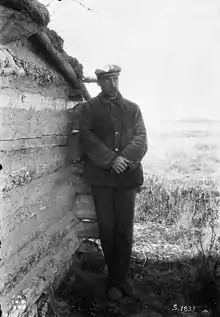James William Tyrrell
James William Tyrrell was a Canadian topologist and author.[2] Like his older brother, Joseph Burr Tyrrell, Tyrrell went on physically demanding expeditions to Canada's sparsely settled, rugged North.

James William Tyrrell | |
|---|---|
| Born | May 10, 1863[1] |
| Died | 1945 (aged 81–82)[1] |
| Nationality | |
| Known for | exploring Canada's largely undocumented Barrenlands |
In 1898 he wrote "Central Canadian Waterways Transit System : Proposed Utilization of the Main Waterways of the Four Great Interior Basins of Canada by Adding Requisite 'divide' Railway Facilities for Improved Transit Thereon", a 14-page pamphlet.
In 1902 he wrote "Across the Sub-Arctics of Canada: A Journey of 3,200 Miles by Canoe and Snow-shoe Through the Barren Lands", based on his expedition to map the land between Great Slave Lake and Hudson's Bay.[2] He led a team of just 9 men.
In 1905 Tyrrell conducted the first survey of the mouth of the Churchill River.[1] Fifteen years later Churchill would become North America's only rail link to the Arctic Ocean.
External links
| Archives at | ||||||
|---|---|---|---|---|---|---|
|
||||||
| How to use archival material |
References
- "James Williams Tyrrell - Encyclopedia Arctica 15: Biographies". Encyclopedia Arctica. Retrieved 2020-12-22.
- Morten Asfeldt; Bob Henderson, eds. (2010). "Pike's Portage: Stories of a Distinguished Place". Dundurn Press. pp. 133–145. ISBN 9781554884605. Retrieved 2020-12-22.